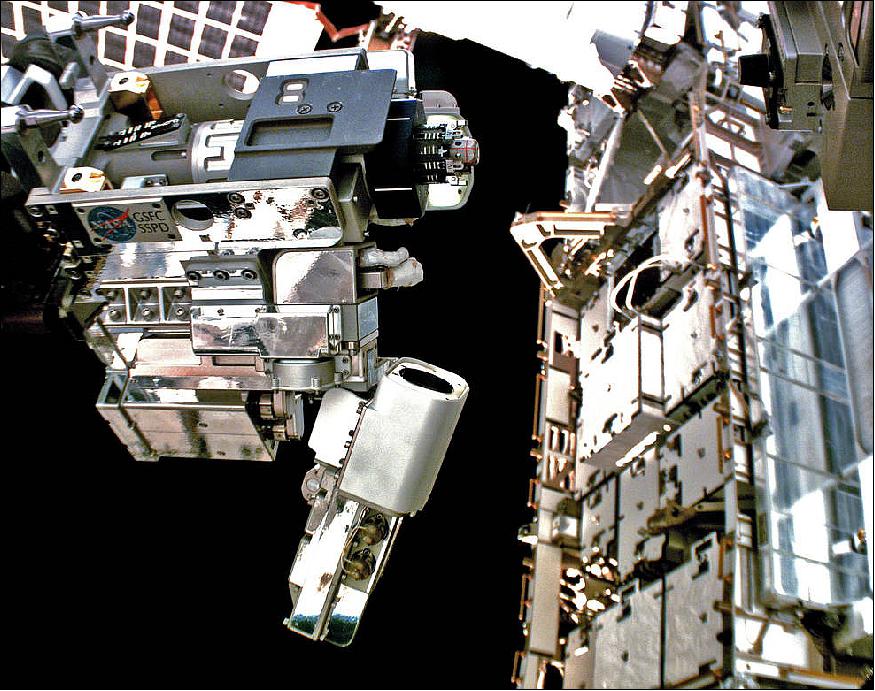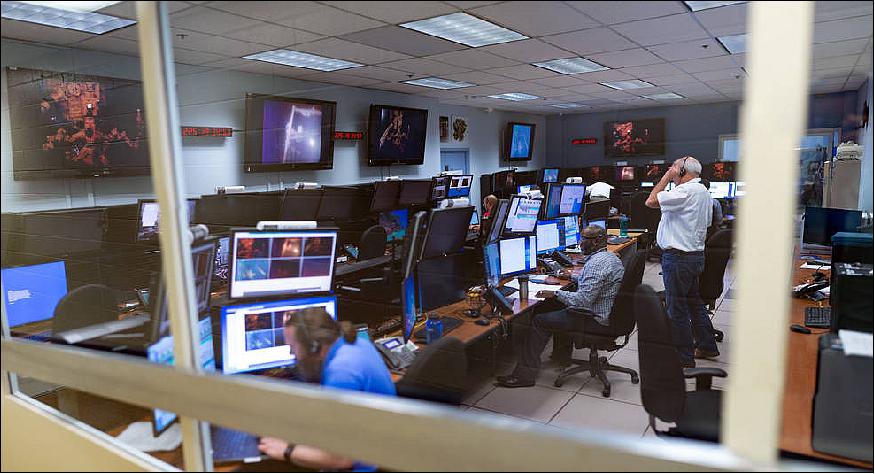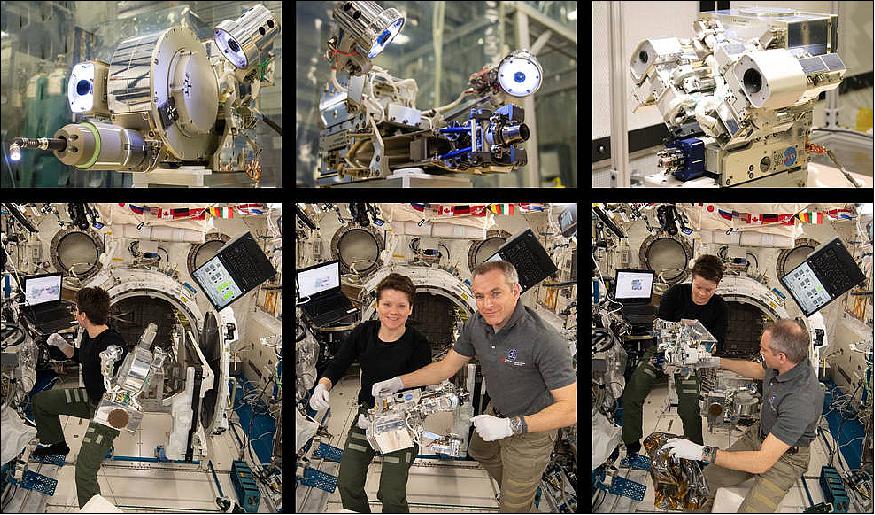ISS: RRM3 (Robotic Refueling Mission 3)
Technology Development
ISS Utilization: RRM3 (Robotic Refueling Mission 3)
Satellites use consumables like propellant and coolant to perform key functions such as maneuvering and maintaining optical equipment. Consumables, by their very nature, eventually run out. The technology to replenish these crucial supplies in space does not currently exist. NASA's Robotic Refueling Mission 3 (RRM3) will help change that paradigm, advancing satellite servicing capabilities and enabling long duration, deep space exploration. 1)
RRM3 builds on the first two phases of International Space Station technology demonstrations that tested tools, technologies, and techniques to refuel and repair satellites in orbit. RRM3 will demonstrate innovative methods to store, transfer and freeze standard cryogenic fluid in space.
The mission is scheduled to launch to the space station in late 2018. It has a projected two-year life on station, though NASA intends to accomplish RRM3's objectives within the first year. RRM3 is developed and operated by the SSPD (Satellite Servicing Projects Division) at NASA/GSFC (Goddard Space Flight Center) in Greenbelt, Maryland, under direction of NASA's Space Technology Mission Directorate.

Cryogenic fluid can serve as a very potent fuel. As a propellant, it produces a high thrust or acceleration, allowing rockets to escape the gravitational force of planetary bodies. As a coolant, it keeps spacecraft operational and can prolong their lifespan by years.
Besides these uses, the ability to resupply cryogenic fuel in space could minimize the amount of fuel spacecraft are required to carry from Earth's surface, making it possible to travel farther into space for longer periods of time.
Liquid oxygen is another type of cryogenic fluid, used for astronaut life support systems. Having the ability to efficiently store and replenish this type of oxygen could facilitate astronauts' capacity to embark on long duration human exploration missions and live on other planets.
"Any time we get to extend our stay in space is valuable for discovery," said Beth Adams Fogle, RRM3 mission manager in NASA's Technology Demonstration Missions program office at Marshall Spaceflight Center in Huntsville, Alabama. "RRM3's ability to transfer and store cryogenic fluid could alter our current fuel constraints for human exploration."
Contained within the RRM3 module is a source tank, filled with liquid methane, and an empty receiver tank, along with various transfer lines. During RRM3 mission operations, the space station's Dextre robotic arm will carry out tasks to transfer liquid methane from the source tank to the receiver tank using a suite of three primary tools. The task sequence begins with the multi-function tool 2, which operates smaller specialized tools to prepare for the fluid transfer. Next, the cryogen servicing tool uses a hose to connect the tank filled with liquid methane to the empty tank. To monitor the process, the Visual Inspection Poseable Invertebrate Robot 2 (VIPIR2) utilizes a state-of-the-art robotic camera to make sure tools are properly positioned.
Storing cryogens in space can be difficult because their extremely low boiling points cause them to boil off over time. The boil off can lead to the formation of one or more large bubbles that increase the pressure in the tank. The bubbles don't rise to the top like they do on Earth, because of microgravity; if a large bubble settles at the opening to the transfer line, it could interrupt the flow of liquid.
Therefore, a critical part of RRM3 will be storing 42 liters of liquid methane for six months with zero boil off, demonstrating methods to more efficiently use cryogens. By using cryocoolers and advanced multilayer insulation to balance temperatures, fluid loss will be dramatically lowered, eliminating the need for oversized tanks and extra propellant.
Launch
The RRM3 payload was launched on 5 December 2018 aboard a Falcon 9 rocket of SpaceX [SpaceX CRS-16 (SpX-16)]. The ISS mission was contracted by NASA and is flown by SpaceX. The launch site was NASA's Kennedy Space Center, Cape Canaveral SLC-40, FL. 2) 3)
Orbit: Near circular orbit, altitude of ~400 km, inclination = 51.6º.
Mission Status
• August 16, 2019: NASA's Robotic Refueling Mission 3 (RRM3) completed an initial set of tool operations, bringing the idea of using water ice or methane from other worlds as fuel for spacecraft one step closer to reality. The ability to store and transfer cryogens (super-cold hydrogen, oxygen and methane) will help spacecraft journey farther into our solar system and beyond. 4)
- The successful operations demonstrated the first of three tools designed by the Satellite Servicing Projects Division to robotically transfer liquid methane from one tank to another in space. Operated by space station's Dextre robot, the Multi-function Tool 2 unstowed the cryogen coupler adapter and inserted it into the cryogen coupler adapter port. This operation would make it possible to then transfer cryogenic fuel using the remaining RRM3 tools. Additional RRM3 tool operations will be carried out later this year.
- RRM3 launched to the International Space Station in December 2018. While the mission is no longer capable of transferring liquid methane due to a hardware issue in April, it has achieved several objectives. RRM3 demonstrated the longest storage of a cryogen without loss due to a process called boil off. Boil off is a loss of fluid that occurs when the cryogen is not maintained at a low enough temperature. Special coolers within RRM3 kept the liquid cold for four months.


• April 12, 2019: On April 8, the Robotic Refueling Mission 3 (RRM3) aboard the International Space Station started experiencing issues powering up its cryogen coolers that maintain the temperature of liquid methane contained within the module. After several troubleshooting attempts, it was determined the coolers could not be powered up. As a result, the temperature of the liquid began to rise. The liquid methane turned into a gas and was safely vented from the payload. There was no impact to other station systems or operations. 5)
- While RRM3 can no longer perform a cryogenic fuel transfer, its four months on station taught NASA about the technology needed to store and transfer cryogenic fuel in space. The mission will carry out other planned operations with servicing and inspection tools. Ultimately, RRM3 will still help bring NASA closer to replenishing cryogenic fuel in space so spacecraft can live longer and journey farther into the solar system.
- RRM3 launched to the space station in December 2018 and is installed to the outside of station on Express Logistics Carrier-1.
• February 27, 2019: Technology drives exploration for future human missions to the Moon, Mars and beyond. For spacecraft to journey farther and live longer, we'll need to store and transfer super-cold liquids used for fuel and life support systems in space. In December 2018, the RRM3 (Robotic Refueling Mission 3) launched to the International Space Station to do just that — transfer and store cryogenic fuel in space for the first time. 6)
Some Assembly Required
- Last week, astronauts Anne McClain of NASA and David Saint-Jacques of the Canadian Space Agency assembled the mission's custom transfer tools and prepared them for installation on RRM3.
- RRM3 consists of two primary parts: the main payload that houses the fluid, transfer lines and tanks and three external tools mounted on a pedestal. The three tools are the Multi-Function Tool 2, which operates smaller specialized tools to prepare for the fluid transfer, the Cryogen Servicing Tool 2, which uses a hose to connect the tank filled with liquid methane to the empty tank, and the Visual Inspection Poseable Invertebrate Robot 2, which uses a state-of-the-art robotic camera to make sure tools are properly positioned.
- Shortly after RRM3's arrival, the space station's robotic arm Dextre affixed the main payload to the station. Meanwhile, the pedestal and tools made their way inside for assembly. With assembly complete, Dextre will soon attach the integrated hardware to the payload.

Looking Forward
- With both parts together in one piece, RRM3 will begin operations in the next few months. Dextre will use the tools to transfer the cryogenic fuel to an empty tank and monitor the process. The technology demonstration will help make future exploration missions sustainable and prove that the whole is indeed greater than the sum of its parts.
- RRM3 builds on the first two phases of International Space Station technology demonstrations that tested tools, technologies and techniques to refuel and repair satellites in orbit. It is developed and operated by the Satellite Servicing Projects Division at NASA's Goddard Space Flight Center in Greenbelt, Maryland, and managed by the Technology Demonstration Missions program office within NASA's Space Technology Mission Directorate.
• Three days after its launch from Florida, the SpaceX Dragon cargo spacecraft was installed on the Earth-facing side of the International Space Station's Harmony module at 10:36 a.m. EST on 8 December. 7)
- While the International Space Station was traveling about 400 km over the Pacific Ocean north of Papua New Guinea, Expedition 57 Commander Alexander Gerst of ESA (European Space Agency) and Flight Engineer Serena Auñón-Chancellor, captured the Dragon spacecraft at 7:21 a.m. EST using the space station's Canadarm2 robotic arm.
- Ground controllers will now send commands to begin the robotic installation of the spacecraft on bottom of the station's Harmony module.
Among the research it will bring to station, science investigations and technology demonstrations aboard Dragon include:
- GEDI (Global Ecosystem Dynamics Investigation). The instrument will be mounted on the Japanese Experiment Module's Exposed Facility and provide the first high-resolution observations of forest vertical structure at a global scale.
- RRM3 (Robotic Refueling Mission-3) will demonstrate the first transfer and long-term storage of liquid methane, a cryogenic fluid, in microgravity. The ability to replenish and store cryogenic fluids, which can function as a fuel or coolant, will help enable long duration journeys to destinations, such as the Moon and Mars.
Next-generation Photodetector Camera
Testing tools and technologies for refueling and repairing satellites in orbit won't be the only demonstration taking place aboard the International Space Station during NASA's RRM3 (Robotic Refueling Mission 3). 8)
An advanced, highly compact thermal camera that traces its heritage to one now flying on NASA's Landsat-8 has been mounted in a corner of the RRM3 payload and from that position will image and videotape Earth's surface below once the SpaceX Dragon resupply vehicle delivers the payload to the orbiting outpost in December.
While RRM3 demonstrates its specially developed satellite-servicing tools developed by NASA's Satellite Servicing Projects Division, its hitchhiker companion, the CTI (Compact Thermal Imager) will image and measure fires, ice sheets, glaciers, and snow surface temperatures.
CTI will also measure the transfer of water from soil and plants into the atmosphere—important measurements for understanding plant growth. Many of the conditions that Earth scientists study, including these, are easily detected in the infrared or thermal wavelength bands.
CTI's enabling technology is a relatively new photodetector technology known as SLS (Strained-Layer Superlattice). In addition to being very small, measuring nearly 16 inches (40 cm) long and six inches (15 cm) tall, SLS consumes little power, operates at liquid-nitrogen temperatures, is easily fabricated in a high-technology environment, and is inexpensive "almost to the point of being disposable," said Murzy Jhabvala, a detector engineer at NASA's Goddard Space Flight Center in Greenbelt, Maryland. Jhabvala collaborated with his industry partner, the New Hampshire-based QmagiQ LLC (Nashua, NH), to develop the SLS detector assembly.
The detector technology is also quickly and easily customized for different applications, he added. The Goddard Detector Development Laboratory, for example, recently fabricated a 1,024 x 1,024-pixel SLS array and plans to increase its size to 2,048 x 2,048 pixels in the very near future.
Another enabling technology that CTI and its SLS detectors will employ is the Goddard-developed SpaceCube 2.0, a powerful hybrid computing system that will control the instrument and process the images and video that it takes while in orbit.
The demonstration's goal, Jhabvala said, is to raise SLS's technology-readiness level to nine (TRL-9) meaning that it has flown in space and has demonstrated that it operates well under the extreme environmental conditions found in space. "This is a very important technology milestone," Jhabvala said. "We needed this mission. When we demonstrate our detector array, multiple copies can be made, assembled, and aligned into focal plane arrays that would allow us to image large swaths of Earth's surface from space in the future."


SLS is based on the established QWIP (Quantum Well Infrared Photodetector) technology that Jhabvala and his government and industry collaborators spent more than two decades refining. The QWIP detectors are now operating on Landsat-8 and will be flying on the upcoming Landsat-9 TIRS-2 (Thermal Infrared Sensor-2), which Goddard scientists built to monitor the ebb and flow of land-surface levels and the health of vegetation—data that western states use to monitor water consumption.
Like its QWIP predecessor, SLS is a large-format detector. The arrays are fabricated on a semiconductor wafer. The wafer's surface consists of hundreds of alternating, very thin layers of differing materials that are epitaxially grown and tuned to absorb infrared photons and convert them into electrons—the fundamental particles that carry an electric current. Only light with a specific energy, or wavelength, can release the electrons. A read-out chip directly mated to the array then converts the electrons to a voltage that a computer uses to recreate an image of the infrared source. The CTI can also capture video from its orbit of about 400 km above Earth's surface.
Compared with its QWIP predecessor, the SLS detectors are 10 times more sensitive and operate over a broader infrared spectral range and at substantially warmer temperatures—at 70 K (about -203ºC) for the SLS array compared with 42 K (about -231ºC) for the QWIP array.
The increase in operating temperature will have multiple positive effects on future missions, Jhabvala said. The warmer operating temperature of the SLS technology implies that its cooling system can be smaller and less power consuming. In the future, these attributes will lead to smaller satellites, increased longevity, shorter build cycles, and a lower cost, Jhabvala said.
Just a few months before the RRM3 launch, Jhabvala reflected on the evolution of his photodetector technology and collaboration with QmagiQ, which has received NASA Small Business Innovation Research grants to create the technology that the CTI team then ruggedized for use in space. "Together, with this company, we have made some outstanding achievements over the years," Jhabvala said. "Our on-going collaboration has yielded some truly extraordinary returns for NASA and the U.S. government. I give QmagiQ and NASA a lot of credit."
References
1) "Robotic Refueling Mission RRM3 - Advancing Servicing Technologies and Driving Exploration," NASA, 20 June 2018, URL: https://sspd.gsfc.nasa.gov/RRM3.html
2) "NASA Sends New Research, Hardware to Space Station on SpaceX Mission," NASA Press Release 18-111, 5 December 2018, URL: https://www.nasa.gov/press-release/nasa-sends-new-
research-hardware-to-space-station-on-spacex-mission
3) "SpaceX Launches Again, Transporting Supplies and Experiments Including Crystals and Dental Glue to the ISS," Satnews Daily, 6 December 2018, URL: http://www.satnews.com/story.php?number=1005465878
4) Vanessa Lloyd and Peter Jacobs, "Robotic Tool Operations Bring In-Space Refueling Closer to Reality," NASA, 16 August 2019, URL: https://www.nasa.gov/feature/robotic-tool-operations-bring-in-space-refueling-closer-to-reality
5) Joshua Finch, Rob Garner, "Robotic Refueling Mission 3 Update - April 12, 2019," NASA, 12 April 2019, URL: https://www.nasa.gov/feature/goddard/2019/robotic-refueling-mission-3-update-april-12-2019
6) Vanessa Lloyd, Rob Garner, "Astronauts Assemble Tools to Test Space Tech," NASA Feature, 27 February 2019, URL: https://www.nasa.gov/feature/goddard/2019/astronauts-assemble-tools-to-test-space-tech
7) Mark Garcia, "Dragon attached to Station, returns to Earth in January," 8 December 2018, NASA space Station, URL: https://blogs.nasa.gov/spacestation/
8) Lori Keesey, "Next-generation photodetector camera to deploy during robotic servicing demonstration mission," Phys.org, 31 July 2018, URL: https://phys.org/news/2018-07-next-generation-photodetector-camera-deploy-robotic.html
The information compiled and edited in this article was provided by Herbert J. Kramer from his documentation of: "Observation of the Earth and Its Environment: Survey of Missions and Sensors" (Springer Verlag) as well as many other sources after the publication of the 4th edition in 2002. - Comments and corrections to this article are always welcome for further updates (eoportal@symbios.space).